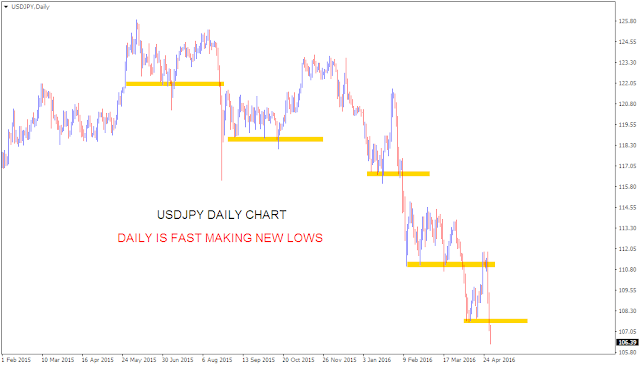
And from Marc to Market, May 1:
Another Strong Jobs Report may Not be Sufficient to Reignite Dollar Rally
The die is cast. The Federal Reserve is on an extended pause after the rate hike last December. The market remains convinced that the risk of a June hike are negligible (~ less than 12% chance). The ECB has yet to implement the TLTRO and corporate bond purchase initiatives that were announced in March. The impact of its programs have to be monitored before being evaluated. It is unreasonable to expect any new initiative in the coming months.
The Bank of Japan did not take advantage of the opportunity to ease policy as it cut both growth an inflation forecasts. The focus ahead of the G7 meeting in late-May, being hosted by Japan, will likely be on fiscal policy, where the Abe government is reportedly trying to cobble together a front-loaded spending bill for earthquake relief and economic support. There have been some calls for a JPY20 trillion (~$185 bln) package, in part funded by a new bond issuance that would be included in the BOJ asset purchase program. (Note that Japanese markets are close for a couple days in the week ahead for Golden Week celebrations).
The US jobs data is typically the data highlight of the first week of a new month. It has lost its mojo. This is more because of the Federal Reserve's reaction function than the ADP estimate that comes out a couple of days earlier. The Fed accepts that the labor market continues to strengthen. The nearest real-time reading of the labor market, the weekly jobless claims, has recently falling to its lowest level since 1973, and continuing claims are at 16-year lows. It is clearly not sufficient for the FOMC to lift rates.
The March core PCE deflator stands at 1.6%, which is a little higher than prevailed when the Fed met last December. Similarly, the 10-year breakeven (10-year conventional yield minus the 10-year inflation-linked note) is also around 30 bp from where it was when the FOMC hiked.
Another 200k increase in nonfarm payrolls is not a game-changer. Even modest earnings growth is unlikely to do much to help the dollar. The FOMC has already taken this on board. The issue is not jobs or income; it is consumption and investment. We suspect the dollar-risk is asymmetrical. It is more likely to be sold on disappointment than rally on a stronger report.
Another highlight at the start of a new month are the European PMIs, and so too next week. The eurozone flash PMIs (Germany and France) were little changed, and that is likely to be seen in the final reading which includes more German and French data as well as other countries, notably Italy and Spain.
Given the seeming urgency of the ECB and the doom-and-gloom commentary that continues to write eulogies for EMU, one would hardly know that growth in the eurozone in Q1 reached 0.6%. This outpaced the UK, which slowed to a 0.4% pace. Rather than report the quarter-over-quarter pace, America reports an annualized figure. The world's largest economy grew at an annualized pace of 0.5%. Incidentally, the Atlanta Fed's GDP tracker projected 0.6% and the NY Fed's version, 0.7%. The point is that eurozone growth looks fairly stable near levels that economists estimate is near trend growth (despite unemployment being above 10% in the region)....MORE